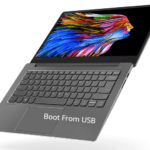We will explain Huawei MateBook 13 Boot from USB guide which can work for Windows and Linux. So without wasting time lets discuss USB boot guide for your Huawei MateBook 13.
What is Boot from USB?
- It is a process of starting a Computer operating system from the USB drive.
- Booting from USB enables to get booting information in a USB rather than using a hard disk or the CD drive.
- All new operating systems support to boot from USB in Huawei MateBook 13.
About Huawei MateBook 13
- Huawei MateBook 13 comes with a 13-inch, 1440p (2,160 x 1,440, IPS, 300 nits, 1,000:1 contrast, 100% sRGB, 3:2 aspect) touch display.
- It is powered by a 1.8GHz Intel Core i7-8565U processor with storage of 512GB SSD and 8GB DDR3 RAM.
- The graphics are powered by Intel UHD Graphics 620.
- It has a battery life of 8 hours and 18 minutes.
- It weighs 1.3kg.
- Finally, Windows 10 OS is pre-installed.
Read More about Huawei MateBook 13 specs
Advantages of Booting from USB?
There are many advantages of Booting from USB over other booting options such as DVD and other which are discussed below,
- No need to purchase any blank CD and you can fill your own stuff along with the ISO file.
- USB Drives are reusable
- Faster read and write than CD
- Very convenient and portable
Disadvantages of Booting from USB
- Booting from USB is depended on the Hardware such as BIOS, motherboard and flash drive model as it may be working with one computer and refuses to another.
- CD has wider support and USB boot functionality is not available for may operating system.
Ways to Boot From USB in Huawei MateBook 13
1. Huawei MateBook 13 USB using Rufus
Download Rufus
- After installing Rufus simply select the ISO file from the file manager and accept all settings when the popup window appears.
- Select MBR partition scheme for BIOS or UEFI and If your laptop has UEFI bios then select the other two options.
- For the Filesystem select NTFS option and select if your PC has UEFI bios then select FAT32.
- The default Cluster size option should be selected.
- Make sure all three options including Quick Format, Create a Bootable disk using and Create extended labels and icon files are selected.
- Finally, start the process and this software will automatically format and create bootable USB flash drive.
2. Huawei MateBook 13 Boot from USB using Unetbootin
UNetbootin enables you to create a bootable USB drive for Live operating system for Ubuntu and other Linux distributions. To create a Bootable Live USB drive follow the instructions below,
Download UNetbootin for Windows
- UNetbootin installs the Linux Distros ISO files for you if you want to use your own downloaded ISO file then follow instructions below,

- To use already downloaded ISO file select the disk image option and provide the location of the file by clicking “…”.
- After selecting the Linux Distribution or ISO file Format your USB drive as FAT32.
- Target the USB drive on your Huawei MateBook 13 and click on OK.
- The process will automatically start and in case the installation doesn’t complete you can reformat USB as FAT32.
3. By using Universal USB Installer
Download Universal USB Installer- Using Universal USB Installer is the easiest way to create a live Linux USB or bootable USB.
- All you need to do is selecting the ISO file, your Flash Drive and, finally, Click Install.
- The process will automatically start and you will receive a ready bootable USB Flash Drive.
Change the boot-order to boot from USB in Huawei MateBook 13
- Turn your Huawei MateBook 13 off or restart it.
- Now connect the bootable USB stick to the port.
- Press F8 button till the boot menu appears and chooses the order to USB.
- Finally, Reboot your Laptop.
Now what? Read some installation guides,
- How to install Kali Linux on Huawei MateBook 13 from USB
- How to install Ubuntu on Lenovo ThinkPad E580 + Dual Boot Windows
Read also –
- Common Huawei MateBook 13 Problems and their solutions
- Complete Huawei MateBook 13 Overheating Problem Fix
Discuss any problem on Infofuge and start by Asking a Question






